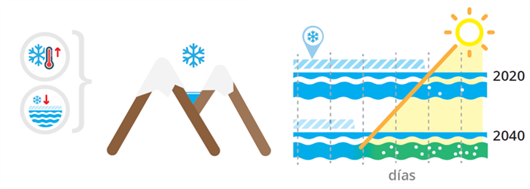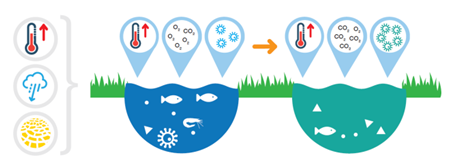Climate change may cause changes to the rivers and lakes of the Pyrenees, especially in the annual contribution of the rivers.

Climate change has generated changes in the average annual contributions of many rivers of the Pyrenees over recent decades. However, these changes are attributed both to climate causes and to changes in land use and plant cover, making it difficult to quantify the influence of each factor separately.
In the Ebro basin, significant decreases of more than 50% in the annual flow rate of the gauging stations studied from 1950 to 2010.
Global warming could also be leading to changes in monthly river regimes.
The decrease in the accumulation of snow each winter due to higher temperatures and less frequent precipitation in the form of snow is leading to higher flow rates in winter.
In contrast, more frequent and intense droughts are leading to lower river flow rates in summer and autumn.
The accumulation of snow below 1,500 m could be reduced by 78% by the last quarter of the 21st century.
Climate change could also affect the quality and quantity of groundwater.
Surface water and shallow aquifers are especially sensitive to changes in climate.
The changes in the water balance mentioned above can be expected to influence the recharging and discharging of the aquifers and may cause water scarcity in areas without sufficient reservoir capacity.
According to the main studies, aquifer recharging could be reduced by up to 20% in some areas of the Pyrenees by the middle of the century. This could mean a reduction of the flow rate in many springs.
Rising temperatures and changes in the water cycle caused by climate change can alter the physical and chemical characteristics of water in the Pyrenees, affecting its quality.

Droughts and longer periods with low water levels have a direct effect on the chemical composition of water, as the reduced amount of water increases the concentration of pollutants, lowering its quality. On the other hand, more frequent and intense floods could lead to increased inputs of nutrients and human-caused pollutant substances in rivers. This close relationship between quality (chemical and ecological) and flow rate has been fully recognised and integrated in the European Water Framework Directive.
The combination of low flow rates and the presence of toxic substances affecting aquatic biological communities is causing structural and functional problems in river ecosystems.
The various impacts of climate change on water masses may have serious effects on their biological composition.

As rivers and streams become warmer, warmwater fish will displace coldwater fish from their habitat.
As a consequence of climate change a widespread redistribution of different species of freshwater fish to higher altitudes has been observed.
Climate change is also affecting algae communities, and water productivity in general, due to a greater concentration of nutrients, higher temperatures, and more hours of sunlight in the case of high mountain lakes.
Recommendations:
- To meet the challenges of climate change in relation to water resources, we must take a comprehensive view of management of the territory, with a new approach to the territorial distribution of water use.
- To deal with knowledge gaps, the studies of climate change impact on the hydrological cycle in the Pyrenees must be reoriented to consider the mountain range as a whole, integrating both northern and southern slopes in a single unit.
- It is also necessary to promote the development and maintenance of climate change monitoring networks, including indicators which facilitate the monitoring and characterisation of climate change impacts on the water balance.
PYRENEAN CLIMATE CHANGE OBSERVATORY
Avenida Nuestra Señora de la Victoria, 8
22.700 - Jaca
Huesca - España
+34 974 36 31 00
info_opcc@ctp.org




